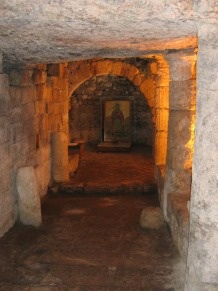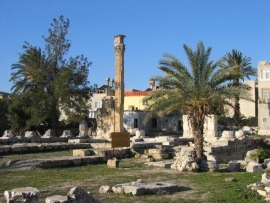Base for visiting Uzuncaburç Population: 66,700
Old name: Seleucia-ad-Calycadnum, Seleucia in Cilicia, Seleucia in Isauria, Seleucia Trachea
Modern Silifke, on the Eastern Mediterranean coast near Tasucu, has the feel of a place that time has forgotten. But, unlikely as it might seem now, it (or rather the nearby village of Tekeler) played a bit part in Central European history in 1190 when the Holy Roman Emperor Frederick Barbarossa drowned in the nearby Göksu river (the old Calycadnus river) while leading German troops to join the Third Crusade.
The precise circumstances of his death may be lost in the mists of time but, gazing down on the freezing waters from the old Roman bridge that still carries traffic through Silifke, it’s not hard to imagine how an old man of 67 could easily have lost his footing and been swept away. A monument commemorating his death stands beside the Karaman road, nine km north of town.
Seleucia was one of several cities founded and given his own name by Seleucus I Nicator in the 3rd century BC. In time it went on to become the capital of the province of Isauria.

Were it not for the lack of decent accommodation Silifke would make a good base for exploring the surrounding area. Unfortunately the local authorities don’t seem to have noticed this…
Around town
High on a hill above Silifke stand the dramatic remains of Silifke Kalesi (Silifke Castle). This dates back to Byzantine times but has been repaired over and over again, including in the early 13th century when the Knights of St John tacked on 23 towers. Restoration has added a clumsy patchwork of new stones to the walls although excavation of the settlement that once existed inside the walls should ultimately prove very interesting.
The same excavations have already unearthed the foundations of a 16th-century mosque mentioned by the traveller Evliya Çelebi.
Sadly the motorcycles with wooden passenger carriers that used to wait for would-be castle visitors near the Roman bridge (77 AD) are no more – without a car you’ll have to walk up to the castle. It’s worth it for the view back over the Göksu river though and for a glimpse of the huge rock-cut cistern faced with stone that stands at its foot.

Silifke Museum (closed Mondays) on the main road heading towards Taşucu is mainly interesting for the fine stonework on display in its grounds.
It’s also worth taking a turn round the Silifke back streets where pieces of old Seleucia crop up all over the place: in the porticoes of the Reşadiye Cami (1328), and as gateposts and bases for the doorposts of private houses.
The remains of a 2nd-century Temple of Zeus also stand right beside the main road, fenced off from visitors for no apparent reason.
Few of Silifke’s old wood-and-stone houses have survived the rush to modernisation, although one lovely house, briefly used by Atatürk, is open to the public, permitting visitors to admire the beautifully furnished rooms of a more elegant age.
Silifke’s other main attraction hides a few km out of town, off the Taşucu road.
According to history, Saint Thecla (Ayatekla, Azize Tekla) of Konya was the first woman to be converted to Christianity by St Paul of nearby Tarsus. After many years of following Paul, she eventually settled in a cave on the outskirts of what was then the town of Seleucia-ad-Calycadnum. Here she is said to have vanished, whereupon her cave became a meeting point and burial place for local Christians.
Later a small church was created inside it while what must have been a stupendous basilica was erected immediately above it in the fifth century. Today only a small part of the apse is still standing, enough to make plain what has been lost.
With time on your hands, it’s worth exploring the area immediately beyond the cave-church where you literally crunch over the shards of what must once have been a large settlement. Most of the ruins are little more than fallen walls but there are two vast open-air cisterns on the western side of the road. They’re reminiscent of the ones to be seen in İstanbul.
Sleeping
Squeezed between the hotels aimed at ferry passengers for Northern Cyprus in Taşucu and those aimed at beach-lovers in Kızkalesi and Atakent (Susanoğlu), Silifke is low on good hotels. You could easily stay in Atakent to take advantage of the greater choice and proximity to the beach and use the frequent dolmuşes to go in and out of Silifke for the sights.
Otel Ayatekla Two-star hotel just across the road from the otogar. Handy for quick getaways but on my most recent visit it was looking very shabby. Tel: 0324-715 1081
Göksu Otel Decent if unexciting riverside two-star. It’s Silifke’s best which is not saying a lot. Tel: 0324-712 1021
Transport info
The nearest airport is in Adana.
There are regular buses to Silifke from Mersin, Taşucu and Alanya. On the western edge of town, Silifke’s old otogar has been renovated rather than moved into the middle of nowhere.
Minibuses run to Atakent throughout the day. It takes 30 minutes to get there. Ditto with Taşucu.
A few minibuses head straight to Ayatekla or you can take any bus heading for Taşucu and ask to be put off at the junction. It’s a short uphill walk to the ruins.
Day trip destinations


